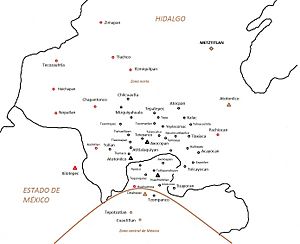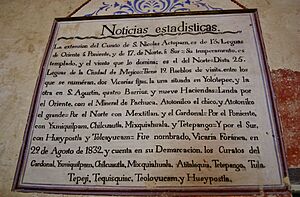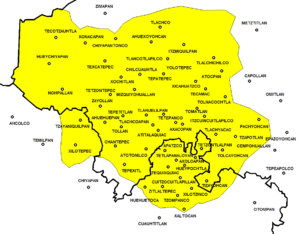Teotlalpan facts for kids
Teotlalpan (which means "land of the gods" or "dry land" in the Nahuatl language) was the old name for a large area north of the Valley of Mexico. Today, this region includes the Mezquital Valley in the state of Hidalgo and nearby parts of the State of Mexico. It was one of the main areas where the Otomí people lived, with another important Otomí region being around Jilotepec and Tula, Hidalgo. Later, in the 1700s, the main part of this region became known as the Mezquital Valley.
History of Teotlalpan
After the city of Tula Xicocotitlan fell, a large desert area was settled by the Otomi people and Nahua people. They formed a new kingdom from 1220 to 1395. However, this kingdom was later defeated by the Tepanec people from Azcapotzalco.
When the old city-state of Xaltocan (which was inside Lake Texcoco) collapsed in 1395, many Otomí people fled north. These Otomí people from Xaltocan settled in new lands, including Teotlalpan, which was located beyond Lake Zumpango.
The ancient records show that the Mexica people (also known as the Aztecs) were not very interested in this area at first. During the time when the Tepanecs ruled, Chimalpopoca conquered Tequixquiac and its surroundings in 1413. Later, as the Mexica empire grew, Moteuczoma Ilhuicamina took control of Axocopan, Atotonilco, and Xilotepec.
However, the Mexica fully took over the northern region only in 1488. This happened during the rule of Ahuitzotl, because the great city of Tenochtitlan needed more supplies.
When the Spanish arrived, the government used religious groups to help control the Teotlalpan region. Franciscan and Augustinian friars taught the native people about Christianity. This land was important for spreading the new religion to the Huastec Region. The Mexica had not valued these lands much. But with the Spanish system of encomiendas (where Spanish settlers were given control over native labor and land), the region was meant for Spanish people to live in and raise cattle.
Geography of Teotlalpan
The Chichimeca-Nahua people called this area a strange, dangerous, and dry land. It was managed by the Kingdom of Acolhuacan. The fields in Teotlalpan were watered by the Tula River. The areas along the rivers were used for irrigation and raising animals. The region has green river valleys but also very dry hills.
Mountains partly surround the area. To the south are the Sierra de Tepotzotlán, Cerro Mesa Ahumada, and Sierra de Tetzontlalpan, which have small oak forests. In the middle is the Cerro del Xicohco. To the east is the Pachuca Range. At the northern end are the Sierra Juárez in Ixmiquilpan, and to the west are the Sierra de Tecozautla.
The exact northern border of the Valley of Mexico was never clearly defined. But Teotlalpan included areas like Hueypoxtla and Axacopan. It was said to start at the end of Otompan. It included towns like Huehuetoca, Tzompanco, Tequixquiac, Apazco, Pachuca, and spread across the dry valley now known as the Mezquital Valley. It reached places like Tepexi, Atotonilco, Ixmiquilpan, and Actopan, bordering the famous city of Tula.
What Happened to the Name?

After the Spanish conquest, the name Teotlalpan was used less and less. In the 1500s, Spanish leaders tried to describe the lands they had conquered. They used the term "comarcas" (a word for small areas) to describe parts of the northern Valley of Mexico. These areas were often isolated and dry. So, they used the name Teotlalpan to describe these native towns.
However, after the mid-1600s, the word Teotlalpan almost completely disappeared from use. In the early 1900s, a historian named Francisco del Paso y Troncoso suggested that Teotlalpan was once a well-organized "province." This idea was later picked up by Sherburne F. Cook in 1949, who thought the Mezquital Valley was the "Teotlalpan."
Today, some people still use the term "Teotlalpan." But it's important to know that there was no "Province Teotlalpan" in ancient times. This idea is more of a story than a fact. The real provinces that paid tribute to the Mexica empire in the north were Hueypochtlan, Axocopan, Xilotepec, and Atotonilco. During the Spanish colonial period, Teotlalpan was called a "minor province" until the mid-1700s. A large part of this land is still known today as the Valle del Mezquital.
The idea of Teotlalpan as a specific area faded away about 30 years after the Conquest of Mexico. It was replaced by the new colonial divisions. No native documents show a clear border for a region or province called Teotlalpan. Also, there are no records of native groups in the north of the central lakes rebelling against the Mexica. Instead, they either traded or quickly submitted. They produced large amounts of quicklime (a material used in building) and textile fibers, even since the time of Teotihuacan.
It's important to understand that the northern region was not a major focus or threat for the Mexica state. That's why it took a long time for them to fully control it. The people in the region did not form a single group or a large alliance. Also, the Otomí people had kept their independence through trade agreements and by being allies of the central power.
See also
 In Spanish: Teotlalpan para niños
In Spanish: Teotlalpan para niños
- Mezquital Valley
- Zumpango Region
- Chichimeca
- Tlacopan
- Tepanec
- Tula (Mesoamerican site)
- Cerro Mesa Ahumada
- Tlaxcala



